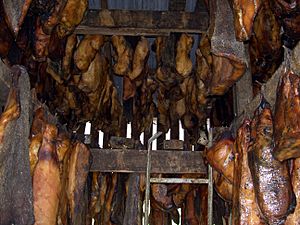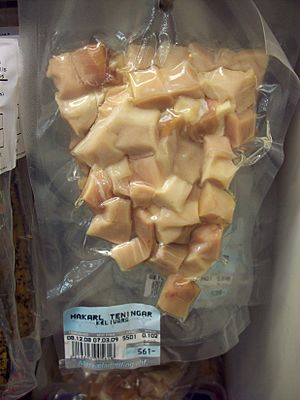Hákarl facts for kids
Hákarl is a special national dish from Iceland. It's also called fermented shark in English. This unique food is made from a type of shark called the Greenland shark or other sleeper sharks. The shark meat goes through a special fermentation process. After that, it hangs to dry for about four to five months. Hákarl is known for its very strong smell, which is a bit like ammonia. It also has a strong, fishy taste. Because of its unique flavor, Hákarl is often called an "acquired taste". This means you might need to try it a few times to start liking it!
You can find fermented shark in Icelandic stores all year round. It's often eaten as part of a þorramatur. This is a selection of traditional Icelandic foods served during the midwinter festival called þorrablót.
Contents
Eating Hákarl
Fermented shark has a lot of ammonia in it. This is why it has such a strong smell, which some people compare to cleaning products. Hákarl is usually served in small cubes. These cubes are often placed on toothpicks, making them easy to pick up.
When people try Hákarl for the first time, they might find the smell very strong. Some even pinch their nose before taking a bite! This is because the smell is often much stronger than the actual taste. Hákarl is often eaten with a shot of a local Icelandic drink called brennivín. This drink is a type of akvavit.
There are two main kinds of Hákarl. One is called glerhákarl, which means "glassy shark". This type is chewy and has a reddish color. It comes from the shark's belly. The other kind is skyrhákarl, or "skyr shark". This one is white and soft. It comes from the shark's body.
How Hákarl is Made
The meat of the Greenland shark is actually poisonous when it's fresh. This is because it contains high levels of chemicals like urea and trimethylamine oxide. But don't worry! When the shark meat is prepared correctly, it becomes safe to eat.
The traditional way to make Hákarl starts with cleaning the shark. First, its insides are removed, and its head is cut off. Then, the shark is placed in a shallow hole dug in sandy ground. The cleaned part of the shark rests on a small pile of sand. After that, the shark is covered with more sand and gravel. Heavy stones are placed on top to press out the fluids from the shark's body.
The shark stays in this hole to ferment for about six to twelve weeks. The exact time depends on the season. After this fermentation period, the shark is cut into strips. These strips are then hung up to dry for several months. While drying, a brown crust forms on the outside. This crust is removed before the shark is cut into small pieces and served. You can see this traditional process at the Bjarnarhöfn Shark Museum in Snæfellsnes, Iceland.
Today, there's also a more modern way to prepare Hákarl. This method involves pressing the shark's meat in a large plastic container. This container has holes that allow the fluids to drain out.
What People Think of Hákarl
Many people from outside Iceland have tried Hákarl, and their reactions are often very strong!
Famous chef Anthony Bourdain once said Hákarl was "the single worst, most disgusting and terrible tasting thing" he had ever eaten.
Another chef, Gordon Ramsay, tried Hákarl on his TV show The F Word. He spat it out! However, his co-host, James May, was able to eat it and even offered to try it again.
On his show Bizarre Foods with Andrew Zimmern, Andrew Zimmern described the smell of Hákarl as reminding him of "some of the most horrific things I've ever breathed". But he also said the dish tasted much better than it smelled. He described the taste as "sweet, nutty and only faintly fishy". Still, he noted that Hákarl is "hardcore" and "not for beginners".
In 2015, on the show Travel Man, Jessica Hynes and Richard Ayoade tried Hákarl in Reykjavík. They called the taste "awful" and "like a jellied cube of ammonia". They also said it was "technically edible".
Biologist Jeremy Wade, from River Monsters, said the meat "smells of urine". He also noted it has a "really strong aftertaste" that "really kicks in at the back of the throat". He compared it to a very strong cheese but with a clear fish flavor.
Archaeologist Neil Oliver tasted Hákarl in the BBC documentary Vikings. He said it reminded him of "blue cheese but a hundred times stronger".
Chef Ainsley Harriott tried Hákarl in his series Ainsley Eats the Streets. He found the strong ammonia taste too much and described it as "like chewing a urine-infested mattress".
Protecting the Greenland Shark
The Greenland shark is an amazing animal. It takes about 150 years for these sharks to become old enough to have babies. Some Greenland sharks can even live for up to 400 years! This makes them the longest-living vertebrate (animals with backbones) in the world.
Because they live so long and reproduce so slowly, hunting Greenland sharks is not good for their population. It can slowly lead to the species becoming endangered. The IUCN has listed the Greenland shark as a vulnerable species. This means they are at risk of becoming endangered in the future. A big reason for this is "bycatch". Bycatch happens when sharks are accidentally caught in fishing nets meant for other fish.
Groups like the Northwest Atlantic Fisheries Organization are asking for a ban on hunting and killing Greenland sharks. This is to help protect these unique and long-lived creatures.
See also
 In Spanish: Hákarl para niños
In Spanish: Hákarl para niños



